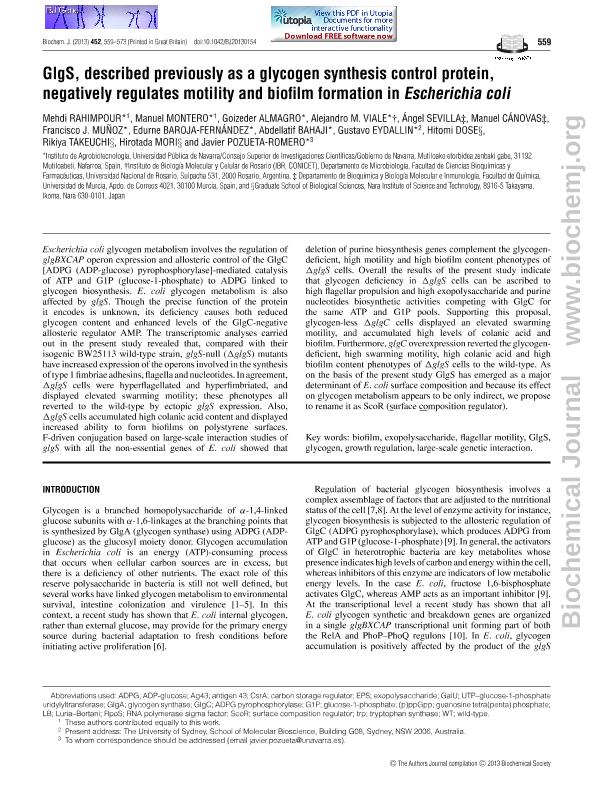Artículo
GlgS, previously described as a glycogen synthesis control protein, negatively regulates motility and biofilm formation in Escherichia coli
Rahimpour, Mehdi; Montero, Manuel; Almagro, Goizeder; Viale, Alejandro Miguel ; Sevilla, Angel; Cánovas, Manuel; Muñoz, Francisco J.; Baroja Fernandez, Edurne; Bahaji, Abdellatif; Eydallin, Gustavo; Dose, Hitomi; Takeuchi, Rikiya; Mori, Hirotada; Pozueta Romero, Javier
; Sevilla, Angel; Cánovas, Manuel; Muñoz, Francisco J.; Baroja Fernandez, Edurne; Bahaji, Abdellatif; Eydallin, Gustavo; Dose, Hitomi; Takeuchi, Rikiya; Mori, Hirotada; Pozueta Romero, Javier
 ; Sevilla, Angel; Cánovas, Manuel; Muñoz, Francisco J.; Baroja Fernandez, Edurne; Bahaji, Abdellatif; Eydallin, Gustavo; Dose, Hitomi; Takeuchi, Rikiya; Mori, Hirotada; Pozueta Romero, Javier
; Sevilla, Angel; Cánovas, Manuel; Muñoz, Francisco J.; Baroja Fernandez, Edurne; Bahaji, Abdellatif; Eydallin, Gustavo; Dose, Hitomi; Takeuchi, Rikiya; Mori, Hirotada; Pozueta Romero, Javier
Fecha de publicación:
03/2013
Editorial:
Portland Press
Revista:
Biochemical Journal
ISSN:
0264-6021
Idioma:
Inglés
Tipo de recurso:
Artículo publicado
Clasificación temática:
Resumen
Escherichia coli glycogen metabolism involves regulation of the glgBXCAP operon expression and allosteric control of GlgC-mediated catalysis of ATP and glucose-1-phosphate (G1P) to ADP-glucose linked to glycogen biosynthesis. E. coli glycogen metabolism is also affected by glgS. Though the precise function of the protein it encodes is unknown, its deficiency causes both reduced glycogen content and enhanced levels of the GlgC negative allosteric regulator AMP. Transcriptomic analyses carried out in this work revealed that, compared with their isogenic BW25113 wild type strain, glgS null (DglgS) mutants have increased expression of operons involved in the synthesis of type 1 fimbriae adhesins, flagella, and nucleotides. In concordance, ÄglgS cells were hyperflagellated and hyperfimbriated, and displayed elevated swarming motility; these phenotypes were all reverted by ectopic glgS expression. Also, DglgS cells accumulated high colanic acid content, and displayed increased ability to form biofilms on polysterene surfaces. F-driven conjugation based large-scale interaction studies of glgS with all the nonessential genes of E. coli showed that deletion of purine biosynthesis genes complement the glycogen-deficient, high motility and high biofilm content phenotypes of DglgS cells. Overall, these data indicate that glycogen deficiency in ÄglgS cells can be ascribed to high flagellar propulsion, and high exopolysaccharide and purine nucleotides biosynthetic activites competing with GlgC for the same ATP and G1P pools. Supporting this proposal, glycogen-less DglgC cells displayed an elevated swarming motility, and accumulated high levels of colanic acid and biofilm. Furthermore, glgC over-expression reverted the glycogen-deficient, high swarming motility, high colanic acid and high biofilm content phenotypes of DglgS cells. Because GlgS emerges now as a major determinant of E. coli surface composition, and because its effect on glycogen metabolism appears to be only indirect, we propose to rename it as ScoR for Surface Composition Regulator.
Palabras clave:
Glgs
,
Bacterial Glycogen
,
Biofilm Formation
,
Motility
Archivos asociados
Licencia
Identificadores
Colecciones
Articulos(IBR)
Articulos de INST.DE BIOLOGIA MOLECULAR Y CELULAR DE ROSARIO
Articulos de INST.DE BIOLOGIA MOLECULAR Y CELULAR DE ROSARIO
Citación
Rahimpour, Mehdi; Montero, Manuel; Almagro, Goizeder; Viale, Alejandro Miguel; Sevilla, Angel; et al.; GlgS, previously described as a glycogen synthesis control protein, negatively regulates motility and biofilm formation in Escherichia coli; Portland Press; Biochemical Journal; 452; 3; 3-2013; 559-573
Compartir
Altmétricas



